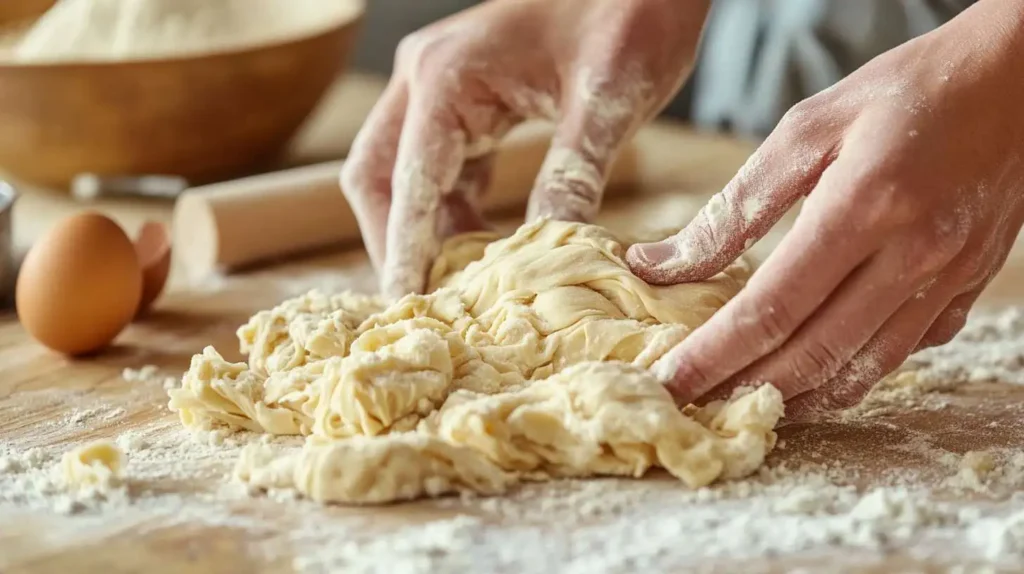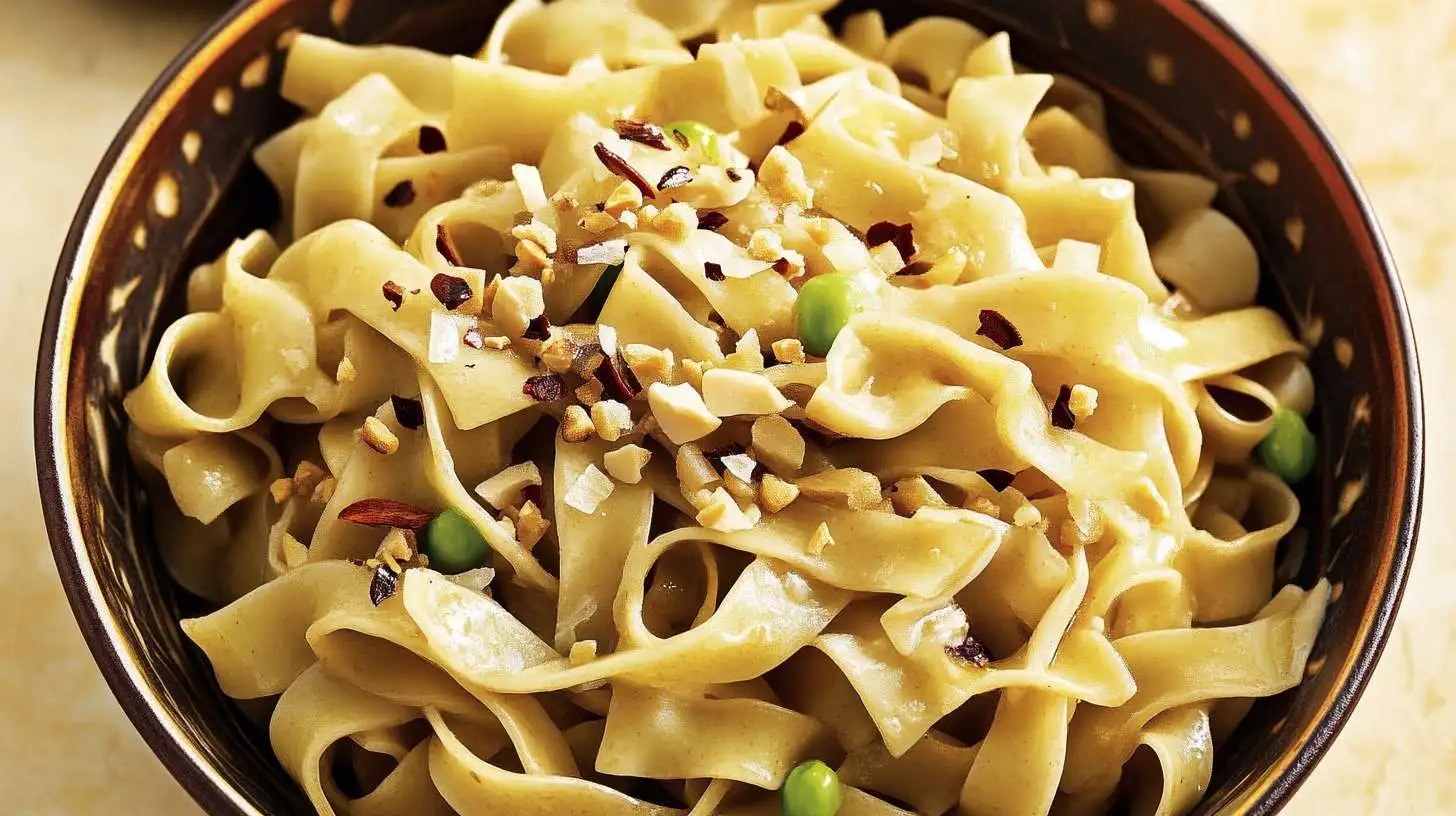A few months ago, my friend Sarah stood in her kitchen, staring at a bag of regular egg noodles with a sigh. Ever since she discovered her gluten intolerance, gluten free egg noodles became her only option, but finding the perfect ones was a challenge. The chewy, comforting noodles she once loved were now off-limits. She had tried countless gluten-free alternatives, but most turned mushy or lacked that rich, satisfying texture.
Then, one evening, she called me, excitement bubbling in her voice. “I finally found the perfect gluten-free egg noodles! They taste just like the real thing!” That moment changed everything for her. From creamy Alfredo to hearty chicken noodle soup, she could finally enjoy her favorite comfort foods without worrying about gluten. In fact, gluten-free egg noodles work wonderfully in various dishes, like this savory cabbage and sausage recipe, which combines hearty flavors with a satisfying texture.
If you’ve ever faced the same struggle, you’re in the right place. Whether you have celiac disease, gluten sensitivity, or simply want a healthier pasta option, these wheat-free noodles are a fantastic alternative. But finding the best ones—or making them from scratch—can be tricky.
In this guide, we’ll uncover everything you need to know about gluten-free pasta, from how it compares to traditional ones to the best brands, cooking tips, and even homemade recipes. Get ready to bring pasta night back to life—without the gluten! 🍜
Table of contents
Key Ingredients in Gluten-Free Egg Noodles
Gluten-free egg noodles rely on a unique combination of ingredients to replicate the texture and taste of traditional wheat-based noodles. Since wheat flour is off-limits, alternative flours and starches are used to create a dough that holds together while remaining tender and chewy. Here are the key ingredients that make up delicious gluten-free egg noodles:

1. Gluten-Free Flours
Instead of wheat flour, gluten-free egg noodles use a blend of naturally gluten-free flours, each contributing different textures and flavors. Some of the most common ones include:
- Almond Flour – Adds a slightly nutty flavor and enhances the richness of the noodles.
- Rice Flour (White or Brown) – A staple in gluten-free cooking, rice flour provides a neutral taste and soft texture.
- Tapioca Flour/Starch – Helps bind the dough and gives the noodles a slightly chewy consistency.
- Potato Starch – Improves the elasticity of the noodles, preventing them from breaking apart.
- Sorghum or Millet Flour – Adds a slight chewiness and enhances the nutritional profile of the noodles.
2. Eggs
Eggs play a crucial role in giving the noodles structure and elasticity. They help bind the gluten-free flour blend, creating a dough that can be rolled and shaped without falling apart. Eggs also add protein and contribute to the rich, golden color of the noodles.
3. Xanthan Gum or Psyllium Husk
Since gluten provides elasticity in traditional noodles, gluten-free recipes often rely on xanthan gum or psyllium husk to mimic this effect. These ingredients help hold the dough together, making it easier to roll, cut, and cook without crumbling.
4. Salt
Salt enhances the overall flavor of the noodles and helps balance the taste of the gluten-free flours. It is a small but essential ingredient in the dough.
5. Water or Milk
A small amount of water or milk is sometimes added to the dough to achieve the right consistency. Some recipes use dairy-free milk for extra richness, while others stick with water for a lighter texture.
6. Olive Oil or Butter (Optional)
Adding olive oil or melted butter to the dough can improve the texture, making the noodles more tender and preventing them from drying out during cooking.
By combining these ingredients, gluten-free egg noodles can achieve a texture and flavor remarkably close to traditional pasta, making them a delicious choice for anyone on a gluten-free diet.
How to Make Gluten-Free Egg Noodles at Home
Making your own gluten-free noodles at home is easier than you think! With just a few simple ingredients and basic techniques, you can whip up fresh, homemade pasta that’s perfect for soups, creamy dishes, and more.. For example, try pairing them with this rich and tangy tomato gravy, a perfect sauce to elevate your homemade pasta dishes. Follow this step-by-step recipe to make your own gluten-free egg noodles from scratch.
Ingredients:
- 1 cup gluten-free flour blend (a mix of rice flour, tapioca starch, and potato starch)
- ½ teaspoon xanthan gum (or 1 teaspoon psyllium husk)
- ½ teaspoon salt
- 2 large eggs
- 1 tablespoon olive oil or melted butter
- 1-2 tablespoons water (if needed, to adjust dough consistency)
Equipment:
- Mixing bowl
- Fork or whisk
- Rolling pin
- Sharp knife or pasta cutter
- Large pot for boiling
Step-by-Step Instructions
Step 1: Prepare the Dough

- In a large mixing bowl, whisk together the gluten-free flour blend, xanthan gum, and salt.
- Make a well in the center of the dry ingredients and crack the eggs into it. Add the olive oil or melted butter.
- Using a fork, slowly incorporate the flour into the eggs, mixing until a dough forms.
- If the dough is too dry, add 1 tablespoon of water at a time until it comes together. It should be soft but not sticky.
Step2: Knead and Roll the Dough

- Lightly dust a clean surface with gluten-free flour to prevent sticking.
- Knead the dough for about 3-5 minutes, pressing and folding until smooth. (Gluten-free dough won’t be as stretchy as regular dough, but kneading helps the ingredients blend.)
- Divide the dough into two portions for easier rolling.
- Using a rolling pin, roll out one portion of the dough into a thin sheet (about ⅛ inch thick).
Step 3: Cut the Noodles

- Use a sharp knife or pasta cutter to slice the dough into thin strips, depending on how thick you want your noodles.
- If making wide egg noodles, cut them into ½-inch wide strips. For thinner pasta, cut them smaller.
- Gently separate the noodles and place them on a lightly floured surface.
Step 4: Cooking the Noodles
- Bring a large pot of salted water to a boil.
- Drop the fresh noodles into the boiling water and cook for 2-4 minutes, or until they are tender but firm. (Cooking time will depend on thickness.)
- Drain the noodles and rinse with warm water to remove excess starch.
- Toss with a bit of olive oil or butter to prevent sticking.
Tips for Perfect Gluten-Free Egg Noodles:
Roll the dough thin – Gluten-free noodles tend to be thicker, so rolling them out well ensures a better texture.
Don’t overcook them – They cook faster than regular noodles, so keep an eye on them.
Use fresh noodles immediately – If storing, let them dry slightly before refrigerating or freezing.
Experiment with flour blends – Different gluten-free flours give different textures, so find what works best for you!
5 Common Mistakes to Avoid When Cooking Gluten-Free Egg Noodles
Cooking gluten-free noodles might seem simple, but they can be tricky if not handled properly. Unlike wheat-based pasta, these delicate noodles require extra care. Avoid these common mistakes to achieve perfect texture and flavor every time!
1. Overcooking the Noodles
One of the biggest mistakes is boiling gluten-free egg noodles for too long. These noodles cook much faster than wheat-based ones, often within 2-4 minutes. If left in boiling water for too long, they become mushy and fall apart.
Tip: Always cook them al dente (firm to the bite) and check for doneness early.
2. Not Using Enough Water
Gluten-free egg noodles release a lot of starch when cooking, which can make them stick together. If you don’t use enough water, they can become gummy and clump up.
Tip: Use a large pot with plenty of boiling water (at least 4-6 cups of water per serving of noodles) to prevent sticking.
3. Forgetting to Stir While Cooking
Since gluten-free noodles are more fragile, they can stick together easily while boiling. Many people forget to stir the pot frequently, leading to unevenly cooked or clumped noodles.
Tip: Gently stir the noodles immediately after adding them to boiling water and every 30 seconds to prevent clumping.
4. Skipping the Rinse Step
Unlike wheat-based noodles, gluten-free egg noodles release excess starch that can make them sticky and gummy. Some people skip the step of rinsing them, leading to a less desirable texture.
Tip: After draining, rinse with warm water to remove extra starch and improve texture.
5. Not Tossing with Oil or Sauce Immediately
Once drained, gluten-free egg noodles can dry out and stick together quickly if left sitting too long. Some people forget to toss them with a bit of oil or sauce right away, making them hard to separate.
Tip: Immediately toss the cooked noodles with olive oil, butter, or sauce to keep them from sticking.
By avoiding these common mistakes, you can enjoy perfectly cooked gluten-free egg noodles every time—whether in a comforting soup, creamy pasta, or stir-fry!
Conclusion
Gluten-free noodles open up endless possibilities for pasta lovers who need to avoid gluten. Whether you’re making them from scratch or choosing a store-bought option, they bring back the joy of pasta night—without the worry.
With the right ingredients, cooking techniques, and preparation tips, you can enjoy delicious, firm, and flavorful pasta in a variety of dishes. Just remember to handle them with care, avoid common mistakes, and pair them with your favorite sauces and seasonings.
Now that you know everything about gluten-free pasta, it’s time to put your knowledge to the test—whip up a homemade batch or try a top-rated brand and enjoy every bite!🍜✨
Frequently Asked Questions (FAQs)
Are any egg noodles gluten-free?
Traditional egg noodles contain wheat flour, making them unsuitable for a gluten-free diet. However, you can find gluten-free alternatives made with rice, tapioca, or almond flour. For a fresher option, try making your own at home using simple gluten-free ingredients!
Are Cantonese egg noodles gluten-free?
No, Cantonese egg noodles are usually made with wheat flour, making them unsuitable for a gluten-free diet. If you’re looking for a gluten-free alternative, you can try rice-based or gluten-free egg noodles in your favorite Chinese dishes.
What is a good substitute for egg noodles?
If you need a gluten-free substitute for egg noodles, consider these options:
- Rice Noodles – Light and delicate, great for soups and stir-fries.
- Zucchini Noodles (Zoodles) – A low-carb, gluten-free alternative.
- Shirataki Noodles – Made from konjac root, very low in calories and gluten-free.
- Gluten-Free Pasta – Many brands offer egg noodle-style gluten-free pasta.
- Homemade Gluten-Free Egg Noodles – The best option for a homemade, traditional taste.
Are Amish egg noodles gluten-free?
No, Amish egg noodles are not gluten-free since they’re made with wheat flour. However, you can easily make a gluten-free version at home using gluten-free flour, eggs, and a binding agent like xanthan gum.

